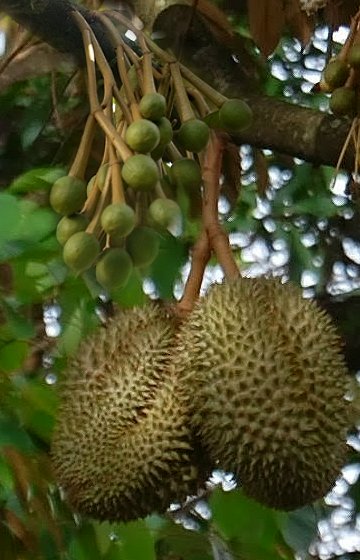
|
|
Durian (Durio zibethinus).
Flowers and fruits.
|
Durian - Durio zibethinus
Durio zibethinus, is the most commonly available of those tree species in the genus Durio that are known as durian, and have edible fruit also known as durian.
Durio zibethinus is found in the Malavaceae family and the Helicteroideae subfamily.
Durio zibethinus is native to Borneo, Indonesia, Malaysia, and possibly Sumatra. The tree has been cultivated throughout the tropics, specifically in: India, Sri Lanka, New Guinea, the Philippians and Central America.
Durio zibethinus grows in cultivation at altitudes of sea level to 700 feet but has been reported at elevations up to 2,600 feet. The durian being a tropical plant requires abundant rainfall (1,500mm-2,500mm, spread over nine to 11 months) and a temperature of 27-30 degrees Celsius with temperatures of 22 and 46 degrees Celsius being the extremes. In cultivation the plant typically flourishes in latitudes up to 18 degrees North and South of the equator.
Durio zibethinus grows to a height of 27 to 40 meters in the wild. The tree has a straight trunk typically 1.2m in diameter. The crown is irregular and densely packed with branches that support oblong evergreen leaves which are six to 25 centimeters in length and two to nine cm in width. These leaves are a glossy green with a point at the apex.
The flower of the D. zibethinus is described as malodorous and yellowish cream in color. The flower has five sepals and three petals, with many stamen and a single stigma. The flowers bloom at night and are formed in pendant like clusters of three to thirty blooms.
D. zibethinus flowers are visited by bats, which eat the pollen and pollinate the flowers. The flowers open in the afternoon and shed pollen in the evening. By the following morning, the calyx, petals, and stamens have fallen off to leave only the gynoecium of the flower.
While studies have shown that bees can be used to pollinate cultivated trees the flower of the wild type D. zibethinus are pollinated primarily by fruit bats. When pollinated the flowers form a fruit commonly known as a durian.
The fruit releases an odor when ripe that makes it that many consumers find offensive. A tough yellow-green, semi woody rind with sharp spines covers the fruit. The irregular ovoid fruits are 15 to 30cm in length and 12 to 15cm in width. Weights of up to eight kilograms are not uncommon. Inside the rind, five compartments house the creamy white to yellow to orange flesh. The flesh is described as having a rich custard texture and tasting heavily of almonds.
The odorous fruit has one to seven seeds within the flesh which are two to six centimeters in length and have a shape and texture similar to an avocado pit.
As with other durian species, the edible flesh emits a distinctive odour that is strong and penetrating even when the husk is intact. Some people regard the durian as having a pleasantly sweet fragrance; others find the aroma overpowering and revolting. The smell evokes reactions from deep appreciation to intense disgust, and has been described variously as rotten onions, turpentine, and raw sewage. The persistence of its odour has led to the fruit's banishment from certain hotels and public transportation in Southeast Asia.
The strong smell of ripe durian fruit, which is extremely unpleasant to many human noses, can be detected half a mile from the source, and thus attracts the attention of a great number of animals that eat the fruit and aid in seed dispersal.
Durio zibethinus is primarily used as a food source which is high in carbohydrates, potassium, and vitamin
C.
There are 30 recognised Durio species, at least nine of which produce edible fruit. Durio zibethinus is the only species available in the international market. The wild type and cultivated fruits are eaten as a local delicacy and are not often seen fresh outside of the tropics do to a short shelf life and a low tolerance for transportation (Soegeng-Reksodiharjo, 1962). The fruit of the D. zibethinus is described as having a slight onion tang with flavors of caramel, vanilla, and banana. The wild type D. zibethinus has been cultivated successfully with well over 200 cultivars found throughout the tropical regions of the world.Many consumers express preferences for specific cultivars, which fetch higher prices in the market.
In rural villages within the durian's natural range a harvesting culture has developed. The villagers build huts around the trees to maximize the fruits collected as they drop. The villagers also set traps around the trees to catch animals and birds which are attracted by the fruits odors (Subhadrabandhu, 2001). The fruits of the D. zibethinus have been known to harm people who unlucky enough to be under one when the fruit drops from its branch. In many places it is customary to wear hardhats while collecting the fruit off the ground; as an added precaution countries such as Indonesia place signs around the trees warning residents and tourists of the falling fruits.
Source:
http://en.wikipedia.org/wiki/Durio_zibethinus
http://eol.org/pages/483665/overview
